|
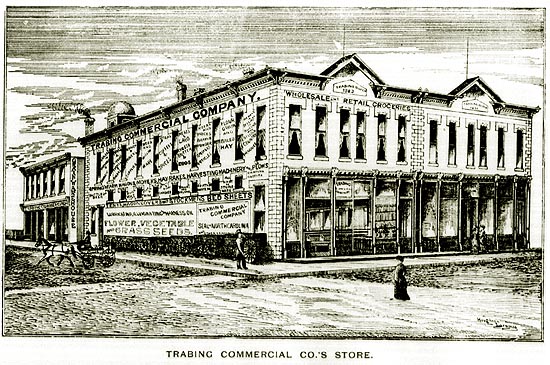
Trabing Commercial Company Store, 1891.
With the railroad and the development of industrial plants, Laramie became a commercial center for southern
Wyoming and northern Colorado. Foremost among the early commercial enterprises were the Trabing Brothers and the Trabing Commercial Company. The bothers'
father came to the United States in 1853 when the elder of the two brothers, Augustus J. "Gus" was age 11. Gus at the time of the Civil War worked with the
Quartermaster General and also did guard duty at forts protecting Washington. With the end of the War, he was assigned first to
Illinois, then to Fort Levenworth and then to Cottonwood, Nebraska providing wood for military posts. In 1868, the Sioux were on the warpath. Trabing had
establsihed a trading post in North Platte Nebraska. His store was burned down by the Indians.
He then moved further west where he establsihed a frighting business between
Rock Creek, Medicine Bow and Powder River country. Trabing and his brother Charles (1846-1885) established the first store in what is now Johnson County at the Crazy Woman Crossing of the
Bozeman Trail. The store was optimistically called "Trabing City." The store was soon robbed. According to Frank Grouard, the robbers were the Big Nose George gang.
In 1869, Trabing moved his headquarters to
Laramie purchasing the old Blue Front Theatre located on South Front Street. The theatre was a one-story wooden structure located in the
three-hundred blook across from the Union Pacific freight depot and about two blocks south of the
passenger station. Charles maintained a store in Medicine Bow. That store was also robbed and
burned down by the robbers. The culprits were never identified. lhe theatre was used as a warehouse. His retail and wholesale store
was located at the corner of Garfield and South Second Street Ultimately, the complex grew to comprise three building conisting of the warehouse,
the store, and stables. Besides freighting and the mercantile business, the brothers engaged in the
stockgrowning.
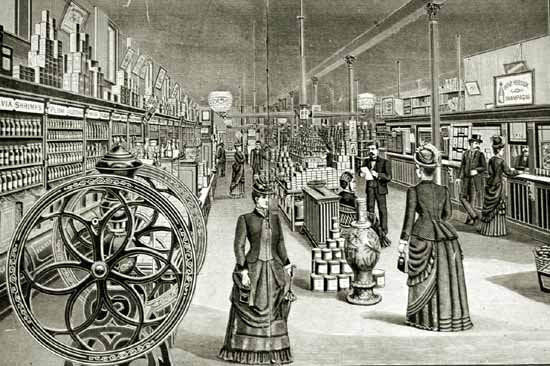
Interior Trabing Commercial Company Store, 1891.
In 1885, Charles was carrying on the Union Pacific cattle to Omaha. At Sherman Hill, Charles injured his finger in attempting to move
one of the steers wedged in a car. By the time he arrived in Omaha, the finger was swollen and painful. He went to a physician who cleaned and
dressed the injury. Nevertheless, the infection became worse. On a public street he dropped dead from apoplexy brought about by blood poisoning.
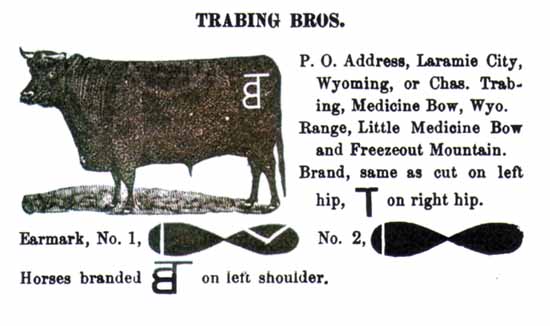
Trabing Brothers Brand
Augustus Trabing served as mayor of Laramie, participated the Wyoming Comstitutional Convention, and was elected to the Wyoming State Senate.
In 1895, the store in Laramie burned with losses of $50,000. Trablin was required to make an
assignment for the benefit of creditors. The business, however, recovered.
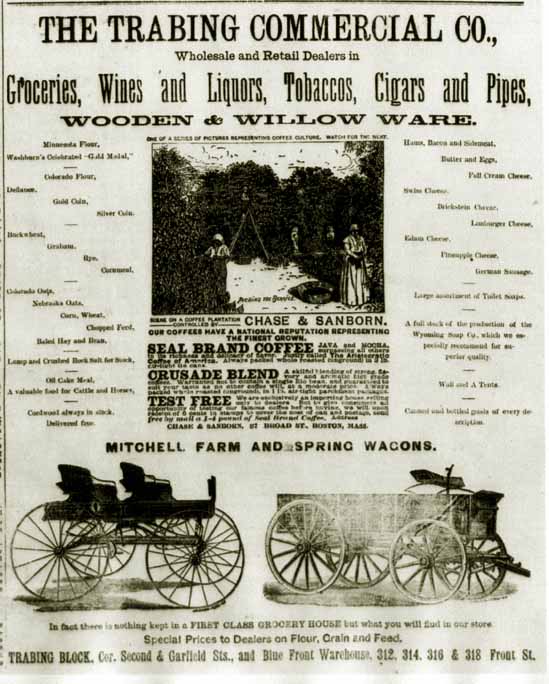
Advertisement for Trabing Commercial Company Store..
In 1891, Congress passed the Indian Depredations Act which
provided for recompense for losses sustained from Indian Depredations. As authorized by the Act, Trabing applied for compensation under the Indian Depredations Act for his losses in Nebraska in 1868. At first, the Government did not
oppose his claim. After its approval by the Court of Claims, the Attorney General in a motion for rehearing, claimed that the court had no jurisdiction to grant the clalim. Claims were only available
to citizens of the United States. It was claimed by the Attorney General that Trabing's father had not become a citizen of the United States prior to Trabing turning 18.
Therefore, the government argued that Trabing was not a citizen of the
United States and was inelegble for compensation.
Earlier, the United States Supreme Court had considered a similar case involving John M. Thayer who had served as wyoming Territorial Governor from 1875-1878. Thayer after serving as Territorial Governor returned to Nebraaska.
There he served two terms as governor. At the conclusion of Thayer's second term as governor of
Nebraska, James E. Boyd was elected as Governor. Thayer then brought an action challenging Boyd's right to the office contending that
Boyd was not elegible; that he was not a citizen and therefore no one was elected and that he Thayer remained as governor until
another election could be held. There, as in the case of Trabling, Boyd had taken an oath of loyalty to the United State, had served the military,
and had held hight office. The United States Supreme Court went through the challenge like the proverbial wet paper bag, stating:
James E. Boyd was born in Ireland, of Irish parents, in 1834, and brought to this country
in 1844 by his father, Joseph Boyd, who settled at Zanesville, Muskingum county, Ohio, and on
March 5, 1849, declared his intention to become a citizen of the United States. In 1855,
James E. Boyd, who had grown up in the full belief of his father's citizenship, and had been
assured by him that he had completed his naturalization by taking out his second papers in 1854, voted in Ohio as a citizen. In August, 1856, he removed to the territory of Nebraska. In 1857 he was elected and served as county clerk of Douglas county; in 1864 he was sworn into the military service, and served as a soldier of the federal government to defend the frontier from an attack of Indians; in 1866 he was elected a member of the Nebraska legislature, and served one session; in 1871 he was elected a member of the convention to frame a state constitution, and served as such; in 1985 he was again elected and served as a member of the convention which framed the present state constitution; in 1880 he was elected and acted as president of the city council of Omaha; and in 1881 and 1885, respectively, was elected mayor of that city, serving in all four years. From 1856 until the state was [143 U.S. 135, 179] admitted, and from thence to this election, he had voted at every election, territorial, state, municipal, and national. He had taken, prior to the admission of the state, the oath required by
law in entering upon the duties of the offices he had filled, and sworn to support the
constitution of the United States and the provisions of the organic act under which the
territory of Nebraska was created. For over 30 years prior to his election as governor he has
enjoyed all the rights, privileges, and immunities of a citizen of the United States, and of
the territory and state, as being in law, as he was in fact, such citizen.
When he removed to Nebraska, that territory was to a large extent a wilderness, and he
spent years of extreme hardship upon the frontier, one of the pioneers of the new settlement,
and one of the inhabitants who subsequently formed a government for themselves. The policy
which sought the development of the country by inviting to participation in all the rights,
privileges, and immunities of citizenship those who would engage in the labors and endure the
trials of frontier life, which has so vastly contributed to the unexampled progress of the
nation, justifies the application of a liberal, rather than a technical, rule in the solution
of the question before us.See Boyd v. Thayer, 143 U.S. 135,
Rather than following the "liberal rule" applied by the Supreme Court, the Court of Claims rejected
Trabing's claim, ruling that Trabing's averment that his father had voted for President Lincoln should be rejected as
"hearsay;" that Trabing's service in Nebraska was before it became a state and thus he did not become a citizen until
after the Indian depredation. The court additionally suggested that Trabing's service as mayor and as a legislator was "wrongful."
The Court seemingly ignored that he had multiple time taken an oath of allegiance to the United States and instead held that Trabing
"apparently chose to remain a subject of a foreign power." See Trabing v. The United States, 32 Ct. Cl. 440 (1897). The wheels of
righting an injustice grind slowly. On January 26, 1907, Congress with the support of Senator Warren and Representative Mondell finally corrected the injustice and directed that
allowed Trabing to prosecute his claim.
See 34 Stat., Vol. 2, p. 883.
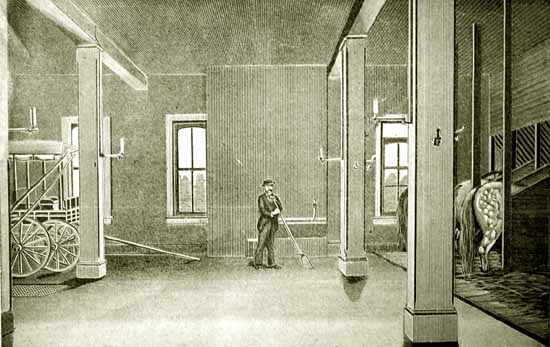
Inerior Trabing Commercial Company stables, 1888.
Unfortunately, justice delayed is justice denied. In 1906, Trabing was residing on his ranch "Wayside," the
 , about twenty miles north
of Laramie near the headwaters of the Upper Chug. The ranch today is remembered in the name of Wayside Ranch Road.
On the evening of October 26 while crossing the Laramie Mountains, his team
became stuck in a snowdrift. Unable to free the wagon, he cut the horses loose and spent the night bedding in the snow beneath the wagon.
The next morning, he trudged a mile and a half to the F. S. King's ranch. Several weeks later, he took his wife to
Wisconsin for the winter. Upon his return later in the month, he spent several days in his room in Laramie before returning to Wayside. , about twenty miles north
of Laramie near the headwaters of the Upper Chug. The ranch today is remembered in the name of Wayside Ranch Road.
On the evening of October 26 while crossing the Laramie Mountains, his team
became stuck in a snowdrift. Unable to free the wagon, he cut the horses loose and spent the night bedding in the snow beneath the wagon.
The next morning, he trudged a mile and a half to the F. S. King's ranch. Several weeks later, he took his wife to
Wisconsin for the winter. Upon his return later in the month, he spent several days in his room in Laramie before returning to Wayside.
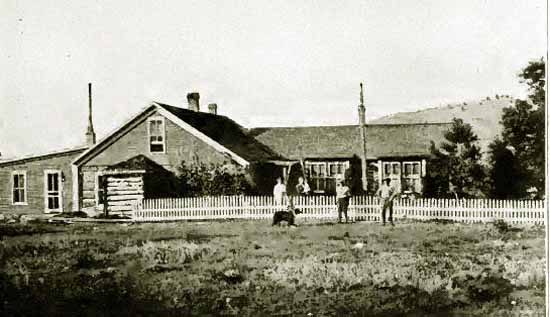
F.S. King Residence, 14 mies northeast of Laramie near the Upper Chug.
On November 28, Trabing became quite
ill. His son-in-law William Bridger rode to the King Ranch about 4 1/2 miles away which had the closest telephone. Bridger arrived at King's and called Dr. Stevens and
his brother-in-law George Trabing. Dr. Stevens and George headed out at once but they arrived at ranch at 2:00 a.m., too late. Thus, also too late was the
passage of the bill in 1907 by Congress allowing Trabing's claim under the Indian Depredations Act.
George Trabing later became sheriff of Albany County and during the 1920's was a prohibition agent with the federal government. In 1931 while dismantling an illegal still near
Bremerton, Washington, anothr agent's gun was accidently
discharged fatally wounding George. After Agustus Trabling's death, Gus's daughter Mablel Bridger took over operation of Wayside. The ranch was sold
about 1919. At the time of his death, Trabing owned in addition to the Trabing Commercial Company and Wayside,
the Laramie-Walden, Laramie-Centennial and Laramie-Sibylee stage lines. A grandson was later
Chief of Police of Laramie.
Next page, Laramie Continued.
|